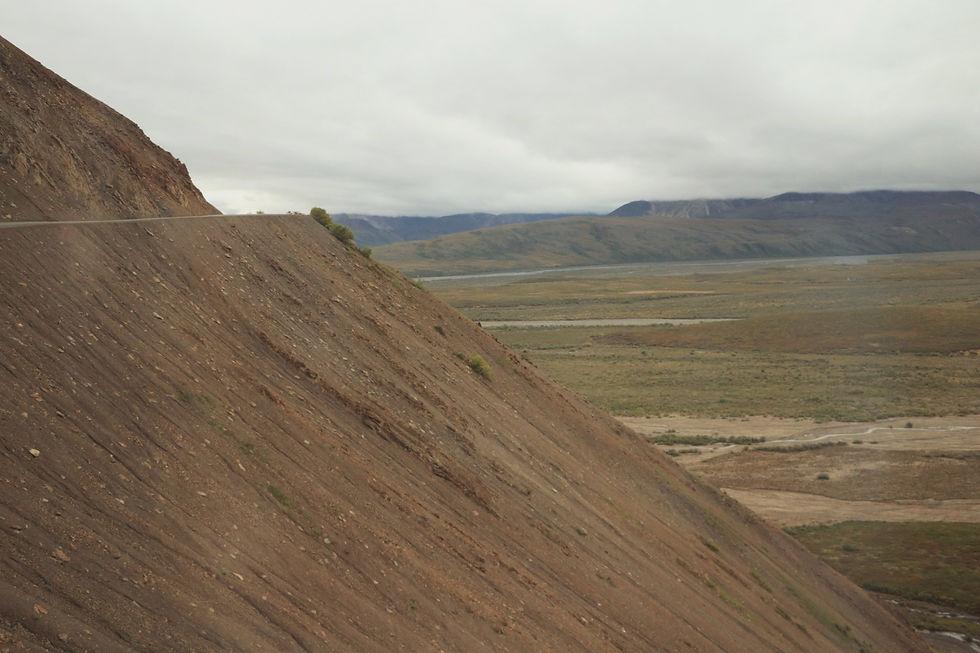Denali Bus Tour
- Sarah Lilley

- Aug 27, 2017
- 3 min read



Tuesday, we took a bus tour into Denali National Park. Private vehicles are only allowed fifteen miles into the park, so these bus tours are the only way to truly see the park. It was scheduled to be around a seven or eight hour tour and we left the Wilderness Access Center at 1:45 p.m..

This is our bus driver, Bruce. He is a recently retired competitive long-distance sled dog racer.

There is only one road going into the park, and it dead ends after about ninety miles. Our particular bus tour went along this road for 50 miles before we turned around.
What we really wanted on this tour was to see some wildlife. Bruce assured us that while the chances were good, there was no guarantee that we would see anything since the park has six million acres. We actually saw some wildlife right away, in the form of a Willow Ptarmigan!

Ok, so it wasn't one of the big mammals we were hoping to see. Still, our hopes were high as we drove deeper into the park. Once we got past the private vehicle stretch of the park road, we started getting out of the valley and into all the mountains we had been seeing from a distance for two days!


The park, which now encompasses six million acres of Alaskan wilderness, was originally created not to protect this wilderness, but a certain inhabitant of it. The Dall Sheep was being overly hunted in the early twentieth century so activists pushed to establish a safe haven for them. Two million acres were set aside on February 26th, 1917, to create Mt. McKinley National Park. This original park did not even include the entirety of Mt. McKinley! In 1980, the park's name was officially changed to Denali National Park and Preserve and another four million acres were added with two million acres designated as wilderness. In 2015, the Secretary of the Interior officially changed the name of Mt. McKinley to Denali.


We saw this little guy after a bit more driving! We didn't know that marmots can really climb, but while we passed by he scampered up all those boulders to get away from the bus.



Our first rest stop was next to this big open valley with the Teklanika river running through. While it might seem as though this river is just dried up, we learned that it never actually "fills," and the river bed is wide because the small stream moves and changes course frequently. You can see old stream courses that are embedded in the ground but no longer in use. This is called a "braided river."



The park road is open for motorized travel for four months of the year, and after that visitors or park rangers get around by dog sled or cross country skis. After the road is closed off, there is no upkeep. It is normal to see subzero temperatures by October!
Yellowstone National Park is one third of the size of Denali, yet Yellowstone's elk population is larger than Denali's entire large mammal population! Because of this, we were surprised to see the animals that we did!

Caribou...

Dall Sheep...

and Grizzly Bears!!!

A mom and her two cubs!
80% of a grizzly bears diet is vegetation, especially roots like the wild pea vine (referred to as the eskimo potato... you learn something new every day).
Unfortunately, we did not see any moose. We did learn that 90% of a moose's diet consists of the willow tree and they eat forty to fifty pounds of it a day.
We stopped at the Toklat Visitor Center next. It's right on the river and low enough so that we could feel the water that was a glacier the day before. Let me tell you... that water is COLD.






We only had a few more miles to go before our turnaround point, and these miles granted us some incredible views.


Our last stop was Polychrome Pass, which was an overlook high above a valley. It was really incredible. I felt like I was in the Land Before Time and half expected to see some dinosaurs walking around.







I don't think I'll ever get over how vast this area was. It made us feel tiny! I was so grateful to be able to visit this park and see one of the few places left that is almost completely untouched by man. God is truly an artist and this place is one of his most beautiful masterpieces!











Comments